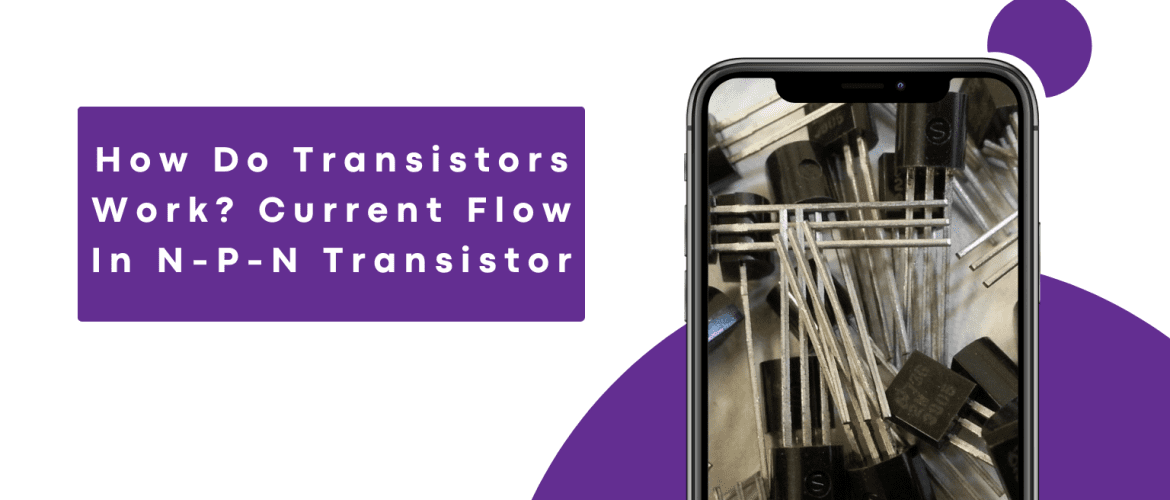A transistor is a fundamental electronic device used for amplifying or switching electronic signals.
It consists of semiconductor material and has three layers, known as the emitter, base, and collector.
Let’s briefly describe the operation of an N-P-N transistor in terms of physics:
N-P-N Transistor
Structure
An N-P-N transistor is made of three layers of semiconductor material.
The outer layers are N-type, meaning they have excess electrons (negative charge carriers), while the inner layer is P-type, meaning it has excess holes (positive charge carriers).
Emitter, Base, and Collector
The transistor has three terminals: emitter (E), base (B), and collector (C).
The emitter is heavily doped with electrons, the base is very thin, and the collector is moderately doped.
Emitter-Base Junction
When a voltage is applied across the emitter and base (forward-biasing the emitter-base junction), it allows electrons to flow from the heavily doped N-type emitter to the thin P-type base region.
This flow of electrons is due to the higher electron concentration in the emitter compared to the base.
Base Current Control
The amount of current that flows from the emitter to the base is relatively small because the base is thin, and the emitter-base junction is forward-biased.
This small current is known as the “base current.”
Transistor Amplification
Here’s where the amplification happens.
The electrons injected from the emitter into the base region are minority carriers in the base because the base is P-type.
These minority carriers are a small fraction of the total charge carriers in the base.
Collector-Base Junction
The collector-base junction is reverse-biased, meaning a voltage is applied such that it opposes the flow of electrons from the base to the collector.
This creates a depletion region at the collector-base junction, reducing the flow of electrons from the base to the collector.
Collector Current
Because of the reduced flow of electrons from the base to the collector, the majority of electrons that entered the base region from the emitter cannot easily escape into the collector.
Instead, they are attracted towards the collector terminal, creating a larger current known as the “collector current.”
Current Amplification
The small base current controls a much larger collector current.
This is the fundamental principle of transistor amplification.
By modulating the base current, you can control the much larger collector current, effectively amplifying the input signal.
Role Of N-P-N Transistors In Electronic Devices
N-P-N transistors play a crucial role in a wide variety of electronic devices due to their ability to amplify and control electrical signals.
Here are some of the key roles of N-P-N transistors in electronic devices:
Amplification
N-P-N transistors are commonly used as amplifiers.
They can take a weak input signal and produce a much stronger output signal.
This property is essential in audio amplifiers, radio receivers, and many other devices where signals need to be boosted for better quality or long-distance transmission.
Switching
N-P-N transistors are excellent switches.
They can act as electronic switches that turn on or off in response to a control signal.
This switching capability is vital in digital logic circuits, where N-P-N transistors help perform binary operations used in computers and other digital devices.
Signal Modulation
Transistors are used in modulation circuits to vary the characteristics of an input signal.
For example, in radio frequency (RF) communication systems, N-P-N transistors are used to modulate the carrier signal with information, allowing data to be transmitted wirelessly.
Signal Routing and Multiplexing
Transistors can be used to route signals selectively from one path to another or to combine multiple signals into a single output.
This is especially important in telecommunication switches and multiplexers.
Voltage Regulation
Transistors can be used in voltage regulation circuits, such as voltage regulators and power supplies.
They help maintain a stable output voltage despite variations in input voltage or load conditions.
Signal Generation
N-P-N transistors can be used in oscillator circuits to generate continuous waveforms, like sine waves, square waves, and triangle waves.
These oscillators are used in applications like clocks, signal generators, and RF transmitters.
Signal Detection
In certain applications, N-P-N transistors are used as detectors to sense changes in environmental conditions, such as light or temperature.
Phototransistors, for example, are N-P-N transistors sensitive to light and find use in applications like optical switches and light sensors.
Audio and Radio Frequency Amplification
Transistors are widely used in audio amplifiers and RF amplifiers for communication devices, such as cell phones and radios, to amplify audio and RF signals for broadcasting and reception.
Signal Conditioning
Transistors are used in various signal conditioning circuits, including filters, equalizers, and tone control circuits, to shape and adjust the characteristics of electronic signals.
Power Control
N-P-N transistors are used in power electronics applications to control the flow of high-current and high-voltage signals.
They are crucial in devices like motor controllers, power inverters, and voltage regulators for power management.
To Summarize
In summary, an N-P-N transistor works by using a small current (the base current) to control a much larger current (the collector current) through the manipulation of charge carriers (electrons and holes) in the semiconductor material.
This controlled amplification or switching action makes transistors crucial in a wide range of electronic devices, from amplifiers to digital logic circuits.
N-P-N transistors are versatile and indispensable components in electronics, serving a wide range of functions from amplification and switching to signal generation and control.
Their ability to control and manipulate electrical currents makes them a fundamental building block in electronic devices of all kinds.




Leave A Comment